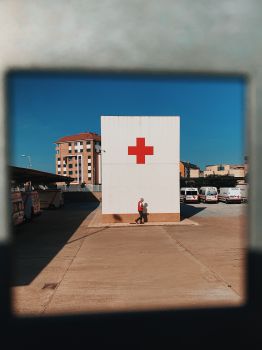
Humanitarian aid. Credit Jon Tyson.
The biggest study of its kind has proven the link between local political context and the risk that humanitarian aid money is lost to corruption. The study also provides reassurance that the controls that donors may insist upon can be effective at preventing money going astray.
The paper "Controlling Corruption in Development Aid: new evidence from contract-level data" is published in the Studies in Comparative International Development journal. It is authored by Liz David-Barrett and Ciara McCorley from the University of Sussex, Mihaly Fazekas and Lili Márk from the Central European University, Hungary, and Olli Hellmann from University of Waikato, New Zealand. The study provides the strongest evidence yet that reforming public procurement to protect aid money is a cornerstone in stemming corruption in development aid.
Liz David-Barrett is a professor of governance and integrity and director of the Centre for the Study of Corruption in the School of Law, Politics and Sociology at the University of Sussex. She said:
"Our findings are based on an unusually large dataset, and an innovative methodology, and so provide strong grounds for what anti-corruption experts have long believed: that better control of public procurement processes may play an important part in tackling corruption.
"Donors can be reassured that their own attempts to control aid spending can be effective at ensuring their money is safely spent too. Donor controls add value especially in contexts where the government's own controls are weakest.
"In short, we've shown that if you can make public procurement less prone to corruption, then you can prevent a lot of aid going astray. Donors try to do this by imposing their own rules on how aid is spent. We show that this can work well, but donor controls should not be one-size-fits-all – different controls are needed in different contexts."
Using an innovative methodology developed by Dr Mihaly Fazekas, the team analysed a huge data set relating to all major contract awards of World Bank-financed projects for the fiscal years 1998-2013.
The team tested their hypotheses on the November 2003 update to World Bank procurement rules, comparing the contracts issued before and after. The 2003 reform significantly increased donor oversight through several requirements:
- the introduction of procurement plans (to which buyers can be better held to account)
- obligatory prior review mechanisms for cases where all bids are rejected (to check that reasons for rejecting bids were legitimate)
- new definitions of corruption and fraud (to clarify what would count as misconduct)
- the extension of oversight to bidders (through audit requirements), and
- improved bidder access to the market by requiring greater use of both electronic advertisement and e-procurement methods.
The researchers found that increasing oversight of public procurement tendering processes, and widening market access – ie encouraging more bidders - decreases corruption risks. Where there was good oversight of public procurement processes, the share of aid-funded contracts that attracted only one bidder (an indication of a corrupt deal) was 18% - significantly less than the rate before the new rules, which was 22 %. That drop is both statistically significant across all models estimated, and substantial in economic and policy terms.
The study found that if recipient governments aren't able to control corruption in public procurement, then donors' own controls can compensate and also potentially help the governments build capacity to control corruption. Donors should therefore not be deterred from giving aid in these contexts if their own controls are good.






